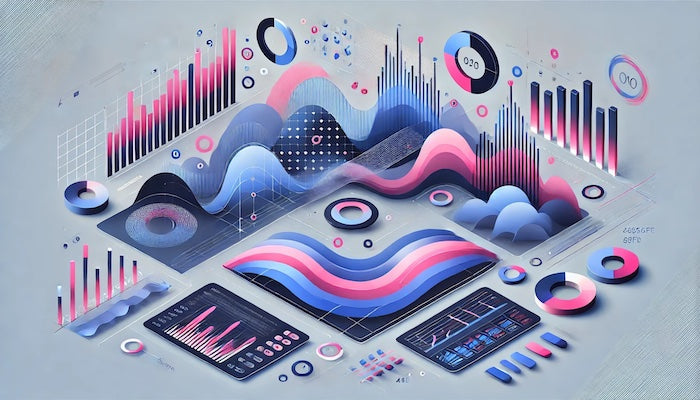As a Shopify agency, we're often asked for our recommendations for data analysis tools to evaluate and categorize data related to your online store. Indeed, the shop system offers powerful statistics and reporting built-in. This allows you to keep track of your customers' behavior and what's happening in your online store at all times.
In this guide, we'll give you an overview of how to navigate Shopify Analytics and which features you should definitely know about when it comes to statistics.

Our e-commerce expert Adrian has already helped numerous brands launch on Shopify. In his book, Shopify for Dummies, he provides retailers with all the essential information they need to navigate Shopify ( view on Amazon / view at your local bookstore ).
He also hosts the Merchant Inspiration podcasts and webinars, where he regularly exchanges ideas with the community's most well-known faces.
1. That's why you should look into statistics and analytics for your online shop
In general, Shopify's analytics section helps you achieve long-term success with your online store by identifying patterns in customer behavior, trends, and potential stumbling blocks. Only with a good overview of your numbers and data can you initiate appropriate optimization measures. In summary, Shopify Analytics helps you with the following points.
- Understand how visitors use your online store
- Identify where visitors are and how they interact with your content
- Analyze what works and what doesn't in your online shop
- Set priorities and decide how to allocate your time and resources
- Identify which places in your online shop offer the highest immediate presence
- To create plans and goals for the coming weeks and months
Overall, the Shopify statistics help you to approach further steps regarding shop expansion in a structured and considered manner.
What are the most successful German brands on Shopify? In our blog, we reveal our top 25 Shopify stores and what they're doing right.
2. Overview: Structure of Analytics & Statistics in Shopify Admin
Log in to your Shopify account and navigate to the "Statistics" section in the menu on the right. This will open an overview with many different charts and data points. Your store backend provides you with a wealth of information in this section. Some of the most important data points in Shopify Analytics are:
- Sales: The total amount you generate in your online store.
- Conversion Rate: The percentage of your visitors who ultimately make a purchase.
- Website visitors The number of people who visit your online store.
- Orders: The total number of orders placed in your store.
- Average order value : The average value of an order in your store.
- Best-selling products: The products that sell best in your online store.
- Cohort analysis: A comparison of different customer groups and their purchasing behavior over a certain period of time.
- Return customer rate: The percentage of your first-time buyers compared to those who buy from you again.
- Sessions by device type: An overview of the devices your visitors use to access your online store.
- Landing pages of your online store: The most popular entry points in your store – the pages your visitors see first.
There are many other metrics you can examine in more detail. Shopify is constantly evolving and regularly adds new data points to help you better understand your online store and visitor behavior, and create detailed reports.
Additionally, you can also access the following two areas in the statistics section:
- Reports : Here you will find a variety of different reports that give you deeper insights into your online shop.
- Live View: In this area, you can track what is currently happening in your online shop, how many people are ordering, and where your visitors are coming from.
Below we take a closer look at the individual key figures and what insights you can draw from them for your data analysis.
2.1. Sales

The sales area shows you how much sales you have made in a certain period of time.
Depending on the selected time period, the display of the intervals on the horizontal axis automatically adjusts. For shorter time periods, the display is set to hourly or daily levels, while for longer time periods, the display is set to monthly levels.
In this view, refunds are processed directly in Shopify. The time of the refund, not the purchase date, counts. Processing many refunds in one day can cause your daily sales to appear lower than they actually are. In extreme cases, you could even experience negative sales.
2.2. Conversion Rate

It's probably the question online shop owners ask themselves most often: What is a good conversion rate? In fact, there's no universally valid answer, as it always depends on the specific case.
It's more practical to focus on continuously improving your conversion rate. Our tip: compare your current numbers with your previous values, rather than measuring them against those of other shops.
What is a good conversion rate in your online shop?
Nevertheless, benchmarks can serve as a guide to assess your own potential. Here are some conversion rate metrics that can serve as a guide:
- Overall Conversion Rate : A typical conversion rate is between 1-3%. However, this value should be viewed with caution, as many external factors can influence it, including industry, seasonality, product complexity, pricing, and awareness.
- Added to cart: A rate of 5-10% is considered very good. If you're below this, it could be due to external factors. Check how well your store is structured and how easy it is for visitors to add products to their cart.
- Shopping cart abandonment rate: This is typically between 40-50%. Fewer than 50% of your visitors should abandon your cart at this point. If the rate is higher, you should investigate why.
- Checkout abandonment rate: This is often between 20 and 30%. No more than 30% of your visitors should abandon their purchase at checkout. If the rate is higher, it's worth analyzing the checkout process more closely.
2.3. Website visitors

Here you can view the number of visitors to your online store. This information tells you how busy or unhappy your store is and how many people have interacted with your products.
2.4. Orders

Here you can see how many orders were placed in your online shop during a specific period.
2.5. Average order value

In addition to the conversion rate, we recommend paying particular attention to the average order value (often referred to as the average shopping cart). A higher average shopping cart value means a higher profit margin for you, as marketing and shipping costs are spread across a higher order value.
How can you increase the average shopping cart value?
An effective approach to increasing the average shopping cart value is the targeted placement and recommendation of suitable products in the online store, also known as cross-selling. Here are some methods we recommend:
-
Free shipping for purchases over a certain basket value: We often implement a progress bar in the shopping cart that shows how far the visitor is from reaching the threshold to demonstrably increase the basket value. Here's how it looks at 3Bears :

-
Product recommendations on the product page or in the shopping cart : You can integrate these either through functionalities in the Shopify theme, through targeted programming or with the help of Shopify apps, such as the AI-based app Rebuy .

Some themes, such as the Impact theme (see example from Flying Pie Me), offer elegant and intuitive cross-selling features. You can find an overview of our top themes on Shopify in our blog.
Through continuous testing and adjustment and subsequent evaluation in the statistics, you can optimize your online shop step by step and improve your key figures.
2.6. Best-selling products

Top-selling products give you insight into which items are currently particularly popular and in demand in your online store. This information is extremely useful for planning purchasing and production accordingly. These insights also help you market and promote your products in a targeted manner.
In our experience, it is often worthwhile to present the best-selling products prominently and centrally on the homepage of your shop in order to exploit their maximum potential and attract the attention of your visitors.
2.7. Cohort analysis

Cohorts refer to a specific group of people who made a purchase in your store at the same time. Typically, you group shoppers from one month together and then compare their purchasing behavior with those from another month.
For example, you can compare the behavior of the May cohort with that of the April cohort. This allows you to determine how many customers return from one cohort compared to another.
These analyses help you understand the impact of your marketing or post-purchase activities on overall purchasing behavior. The goal is to ensure that cohorts develop positively and improve over time.
Improve cohorts using retention marketing - tips:
To improve your cohorts and convert more one-time buyers into returning, enthusiastic customers, you can optimize various levers. This is often referred to as "retention marketing." The goal is to retain a customer once acquired for as long as possible and increase the value of their orders over their entire lifetime (customer lifetime value).
Here are some areas of the customer experience that you can improve:
- Fast shipping & proactive communication on shipment status
- Proper & high-quality packaging / unboxing experience
- proactive communication via email and other channels
- approachable and solution-oriented customer support
- smooth returns management
You can achieve many of these aspects with the right tools. In our guide, we reveal which top Shopify apps our experts rely on.
2.8. Rate of returning customers
The returning customer rate shows you how many of your orders come from new customers compared to returning customers. Typically, you want the percentage of returning customers to grow continuously, as this usually means you spend less on marketing and thus achieve higher margins.
If you have a relatively low proportion of returning customers in an already established online shop, we recommend that you focus more on retention marketing.
2.9 Sessions by device type

These metrics tell you which devices your visitors use to access your online store. How many come via mobile devices and how many via desktop? This data helps you determine which devices you should focus on.
Today, typically 70%-90% of all visitors to an online store arrive via mobile devices. Only 10%-30% of visitors use the desktop version.
We recommend keeping this in mind at all times. Pay particular attention to the mobile version of your online store. Shopify offers all the necessary features to ensure your store displays optimally on both desktop and mobile devices.
However, if you find yourself in situations where you have to choose between the desktop and mobile versions, our advice is: For most D2C/B2C brands, it's worth prioritizing the optimal display of the mobile version.
2.10. Landing pages of your online shop

In this area you can see which pages your visitors first enter your online shop.
This gives you a quick insight into which landing pages and product pages in your online store are most important and deserve your special attention. Optimizing and refining these first pages is essential to prevent visitors from losing interest after the first few seconds and abandoning their purchase.
In fact, the entry points for online shops vary greatly. While some brands are found via Google and visitors usually land on the homepage, for other brands that advertise heavily on social media or specifically promote individual products, the product pages are the first entry pages.
These differences have a major impact on the design and placement of content on your various pages. A look at this data will help you set the right focus and optimize your online store in a targeted manner.
3. Create reports in Shopify

In addition to the pre-built visual tiles available in your online store's Analytics section, Shopify also offers deeper insights into your data in the form of reports. To access these reports, go to Analytics in your store account and select Reports.
You have access to a variety of reports in your online store that help you gain detailed insights into various aspects of your business. These reports allow you to comprehensively analyze your data and make informed decisions to further optimize your online store.
In Shopify Editions Summer 2024, Shopify announced it would expand its analytics offering and enable even more detailed reporting. In addition to real-time data analysis, the focus is on more customizable metrics displayed in the dashboard and flexible reporting.
4. Live view in Shopify Analytics
This area will be particularly exciting for you if, for example, you are planning a large sales campaign, marketing campaigns or TV appearances and want to know how many visitors you attract to your online shop at the same time.
Using Live View you can see the following:
- How many visitors are currently in your online shop
- How much revenue you are currently making
- Which parts of the world your visitors come from
- Which products are particularly popular
- How many visitors are currently where in your funnel
5. The best Shopify apps for data analysis
Our guide has shown you that Shopify provides a variety of built-in analytics options for your data. But are you missing specific information or even more in-depth statistics? Don't worry, we can recommend external tools that are guaranteed to meet your needs.
5.1. Google Analytics and Shopify
Google Analytics is the most common tool for collecting data and analyzing visitor behavior in more detail. It's free and can be integrated into your online store to provide detailed information.
To connect Google Analytics, go to Sales Channels > Online Store > Settings in your store account. Scroll down to the Google Analytics section. Click the "Manage pixels here" button. You'll be asked to add Google and YouTube as sales channels. Continue with the installation and setup to link your Google Analytics account to your online store.

5.2. Clear Analytics
In addition to Google Analytics, there are numerous other Shopify apps for deeper data analysis. You'll find various options in the Shopify App Store to expand your analytics. One of our top recommendations is:
- Klar Analytics : This app serves as a central hub for your online store's success metrics. It analyzes customer lifetime value, profit margins, and marketing metrics to optimize your marketing.
By integrating these tools, you can further deepen your online store's data analysis and make even more informed decisions.


